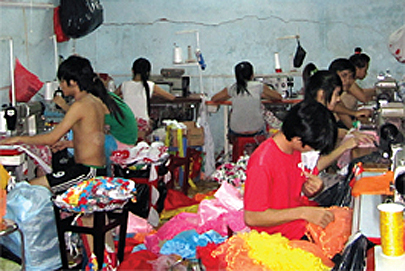Anti-slavery rescuer earns a hero’s recognition
U.S. Department of State honors Heller alumnus
 Photo/Blue Dragon Children's Foundation
Photo/Blue Dragon Children's FoundationChildren as young as 10 are trafficked to work in garment factories in Southern Vietnam.
Using modern technology and old-fashioned investigative techniques, sometimes with only a photograph and a vague location to guide them, the Vietnamese lawyer and his team of activists search for children and women forced into modern-day slavery. In 2013 alone, Van Ta and his team traveled to China on seven rescue missions, freeing 13 girls and women who had been sold into prostitution.
Last week, U.S. Secretary of State John Kerry named the Heller alumnus a “Trafficking in Persons Hero” at a Washington ceremony attended by ambassadors, politicians and other dignitaries. Nine other individuals fighting human trafficking were also recognized.
“If the cries of those who are enslaved around the world today were an earthquake, then the tremors would be felt in every single nation on the continent on every continent simultaneously,” Kerry told the audience. “For years, we have known that this crime affects every country in the world, including ours. We’re not exempt. More than 20 million people, a conservative estimate, are victims of human trafficking.”
Van Ta (his full name and photo are being withheld to protect his anonymity and safety), who works with the Hanoi-based Blue Dragon Children’s Foundation, was profiled in a feature that appeared in the Winter 2014 issue of Brandeis Magazine.
Phillip Martin, senior fellow at Brandeis’ Schuster Institute for Investigative Journalism, met Van Ta when Martin wrote a series of award-winning investigative pieces about human trafficking for WGBH Boston Public Radio. In Brandeis Magazine, Martin described the dark nights when Van Ta drives the streets of Ho Chi Minh City to find children who have been trapped by garment factory owners.
“At 2 or 3 o’clock in the middle of the night, you see groups of men hanging out outside, almost as if they were monitoring the buildings,” Martin said. “The factories look more like apartments, with heavy gated barriers in front. Through the gates, you can see kids sewing garments. … They work 16-hour days and get paid less than a dollar a day, and that’s only after they’ve put in two years of service.”
Between 2005-10, before coming to the Heller School for Social Policy and Management, Van Ta had rescued 90 victims of trafficking. Since he earned his master’s in 2012, he says his team has rescued more than 330 victims total. He attributes much of his increased success to two new anti-trafficking programs his training in Heller’s Sustainable International Development program helped him develop.
“The best part of a rescue mission is the moment when the girls come home and are held in their parents’ arms,” Van Ta told Brandeis Magazine. “They all burst into tears — I understand how happy they are.”
Categories: Humanities and Social Sciences, International Affairs





